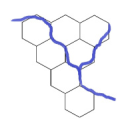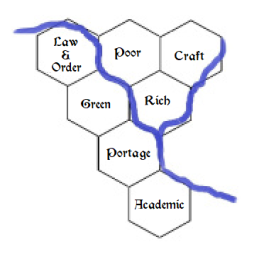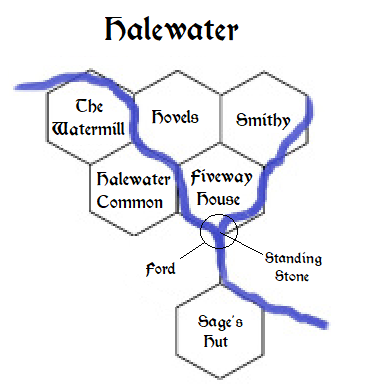Today I had an urge to create a small hamlet. Lucky for me… (cue shameless self-congratulations)… I have a Fantasy Town Creation System!
What are my goals here?
Well, my only real goal here is to create a little hamlet that would make a good home town for a classic PC. (What do I mean by “classic PC”? Well, I guess I’m thinking especially of the “blacksmith’s son who takes up his father’s sword and finds adventure.” That sort of thing, anyway. Tried and true!)
Step 1: Theme
What’s the overall Theme of this little hamlet?
(Rolling…) 2,6: “Infernal”
Erk! That seems far too dramatic for what I’m envisioning as a sleepy little village. Maybe in the distant past? Let’s keep it in mind, and roll again.
(Rolling…) 6,1: “Safe”
Ah, that’s more like it! Our hamlet’s role in the story is as that safe, peaceful, home-like place that the characters will remember fondly when they’re away doing exciting and dangerous things. It’s a Shire, if you will. So “Safe” it is.
But I don’t want to let go of my first roll entirely. Let’s say that once upon a time the hamlet had a problem with demons. But that’s ancient history – these days the town’s distant infernal past is just considered a bit of quaint old folklore, virtually a myth.
Great! Only two rolls of the dice, and we have not only a Theme, but a story hook. Let’s proceed.
Step 2: Memorable Feature
What’s this hamlet’s most memorable feature?
(Rolling… 6,4: “Peculiar Custom”)
Oh, interesting – ok. Is this a strange local taboo? A distinctive accent? It’s usually best to tie the Memorable Feature into the settlement’s Theme, so this custom ought to feel very Safe (but maybe hint subtly at an Infernal past…). How to do that? Hmmmm…
I know. Let’s say that there’s an ancient standing stone somewhere in the area. The local custom is to shade your eyes when looking at it, as if you were trying to see into the glare of the sun. The locals say that this gesture helps to “ward off the demons in the stone.” Now, this is a fantasy world, so this might sound quite scary, but in fact no-one takes it seriously – the local people are entirely confident there are no demons in the stone – it would be absurd to suggest such a thing! But they still shade their eyes, just as their ancestors did long ago, and they still say that it’s to ‘ward off demons.” To them, it’s just a bit of quaint local folklore, beloved mainly because it’s theirs.
In fact, people who grow up in the hamlet sometimes use this gesture as a joke: if your friend has just said something crazy, you make a big fuss of squinting at them while shading your eyes, as you’re struggling to make out the truth in what they’re saying, while warding yourself against their demonic influence. This is a good-humored way of suggesting that they’re loco. And it’s fun, too, because only locals understand the gesture, so understanding the joke marks you as members of the same community.
 Step 3: Layout
Step 3: Layout
What’s the town’s layout?
(Rolling, Rolling…) Ok, so the hamlet is built at a point where two little streams converge, as per the blank map on the right ->
Step 4: Districts
 What are the main areas of the Hamlet? Let’s see…
What are the main areas of the Hamlet? Let’s see…
(Rolling, rolling..)
Ok – now the town map looks like this: ->
What can we make of this layout? It gives me a few ideas.
- I notice that the “Poor”, “Rich”, and “Craft” areas are all on the little triangle of land between the streams. These seem like the kinds of areas where most people in the hamlet would actually live, so I envision this as the center of the hamlet. The “craft” area is obviously the blacksmith’s workshop!
- That leads me to think that everything on the left-hand side of the stream is kind of on the outskirts of the hamlet.
- The “Law & Order” area, I imagine as the home of the local constable, magistrate, or bailiff, just a small way out of town. (Maybe up on a hill, overlooking the stream?)
- The “Green” area might be a village common, where they graze sheep, set up a maypole once in a while, or similar. I’m also wondering if this might be the location of the standing stone we invented a moment ago.
- The “Portage” area might be a ford or bridge – some way to cross the stream, anyway.
- I imagine the “Academic” area as a little hut belonging to the local wise-person – a “Goodwife”, witch, local scholar, or similar.
That’s enough speculation for now. Let’s keep rolling!
Step 5: Memorable Features for Districts
Now is my chance to flesh out each of these areas a little, by providing each with its own small memorable feature. I’ll roll for each of these, and summarize as I go.
Let’s start in the core of the village, and then move outwards.
- Let’s start with the Poor area. I envision this as a few very modest little huts belonging to the various unlucky people – perhaps serfs. What’s its memorable Feature? (Rolling…) 4,1: Internal Conflict. Ok – so the families who live here don’t get along. I wonder why? Is there some kind of feud? Do their masters pit them against one another? Are a few of them just ornery? All this makes me want to roll up some NPCs… Well, maybe later.
- Let’s now head to the Rich area. I envision this as a couple of larger wooden houses – the homes of more prosperous farmers. What’s the memorable feature? (Rolling…) 5,5: Unusual Streetplan. Hmmm… I’m not sure quite what to make of this. Maybe it will help to remember my basic principle: “if in doubt, tie it into the Theme.” Hmmm…. Ok: let’s say that the five finest houses in town are laid out in an odd radial pattern, so that they all angle out from one another, like the spokes of a wheel. They’re joined at the center, and collectively they’re just known as the “Fiveway House.” The “Five Families” who reside in the five houses are the most important families in town, and have been for many generations. At any rate, this unusual layout gives the center of the village a festive feeling – the Fiveway House forms a kind of natural hub, and the village children love to chase each other around it.
- (Why did they build these five houses in such an odd layout? Well, the houses are timber, and only a few centuries old, but they’re built atop truly ancient stone foundations, dating back to more troubled times. It’s possible that the strange layout of the foundations has something to do with resisting demonic influence…. But that’s all ancient history, of course. Naturally it would never come up in a campaign…)
- Now for the Craft area. Currently I’m envisioning this as the blacksmith’s home and workshop – but let’s see if the Memorable Feature changes my mind. (Rolling…) 1,4: Historic Change. Ok, the dice are obviously telling me to continue in my current vein, so let’s say that the Blacksmith’s workshop has been built using ancient stones salvaged from the ruins of some previous structure. As a result, it’s got more stone, and less timber, than most of the other buildings in town (which is probably for the best, since forges are a real fire hazard!)
- Heading over to the other side of the stream, what about the Law & Order area? (Rolling…) 6,6: Valuable Goods. Ok, I know: let’s say that this area is actually a Watermill, the property (and residence) of the Miller, who is the King’s representative in town (assuming there is a King). The Miller collects the King’s Taxes (i.e. charges fees for grinding grain), and enforces the King’s Peace (i.e. locks up wrongdoers in the sturdy stone basement of the mill). The Miller sometimes comes into conflict with the Five Families: he represents the King’s interests, whereas they represent local interests.
- Now for the Green area. I’m envisioning this as a common, on which the people of the hamlet graze their sheep. What’s it’s memorable feature? (Rolling…) 2, 1: Communal Desire. Ahah! Just a moment ago we discovered that the Miller sometimes comes into conflict with the Five Families – now let’s flesh that out a little, by saying that the conflict is often over how to use the Common. For his part, the Miller claims that everyone in the village has a right to graze their animals on the common, by the King’s order – whereas the Five Families claim that grazing rights on the common belong to the Fiveway House, which means that they are the only ones with the ancestral right to graze their animals on the common. The dispute is unresolved, and generates a lot of tension.
- What about this Portage area? I’m envisioning it as a bridge or ford over the stream, but we’ll see. (Rolling…) 2,6: Impressive Structure. Ahah! I know what this is: it’s the Standing Stone we found out about earlier. In fact, for a bit of extra color, let’s say that the standing stone rises dramatically up out of the shallow water, right where the two streams come together. Around it, there’s a broad, rocky, shallow ford area where it’s easy to cross either stream without getting too wet. The people of the hamlet use this ford a lot, which means they pass the standing stone a lot, too (and make their distinctive “shading the eyes” gesture).
- Another little bit of colour: the people of the hamlet have laid down planks between the larger rocks, to make it easier to cross the ford without getting wet. These are pretty effective, but they tend to wash away in the spring floods; thus every year they need to be rescued from downstream, or replaced entirely.
- Now for the last one – the Academic area. (Rolling…) 2,3: Famous Person or Group. Ok – it looks like this is the house of a famous witch, sage, scholar, or wise person (Well, “famous” by the standards of a sleepy little backwater hamlet, that is. Maybe it’s better to describe them as “well-known in the local area”). They’ve chosen to live here, on the outskirts of town, because they’re an outsider (and maybe also because they like peace and quiet for their research?) I’m looking forward to creating this person as an NPC.
Naming the Hamlet
Right! Now we’ve laid the foundation of this hamlet – so let’s give it a name. To the naming tables!
I’ll start by rolling for a word or two relating to the “Safe” theme, just for inspiration. Then we’ll see where we end up.
(Rolling…) 3,6: Halewater. That’s pretty good for a first try! It sounds safe, and it seems appropriate for a hamlet built at the confluence of two streams. But I wonder if perhaps it would be better to use that as the name of the stream, and name the hamlet itself after the ford?
I have an urge to riff on this. What about “Haleford” (i.e the ford over the Halewater?) Maybe “Haelford,” for an older feel?
Another thought: the most distinctive natural feature is the standing stone in the middle of the ford. “Stenford”? “Stenwater”? “Halsten?”
 Hmmm… Well, on reflection, I think I’m just going to stick with the very first roll: “Halewater”. I like the sound of that.
Hmmm… Well, on reflection, I think I’m just going to stick with the very first roll: “Halewater”. I like the sound of that.
Clearly there’s a lot more I could do to colour in here (I’d especially like to make some of the key NPCS). But the bare bones of the thing have been laid down.
The last thing to do for today is to update the map. Check it out just here!
In days to come, I may find the time to flesh the town out by rolling up a few key NPCs. EDIT: And I did!
One thought on “Creating Halewater”